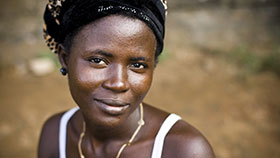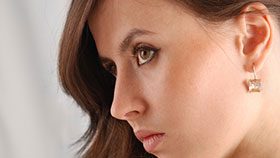Medical Dermatology

Acne Treatment
Acne is the term for the blocked pores (blackheads and whiteheads), pimples, and deeper lumps (cysts or nodules) that can appear typically on the face, neck, chest, back, shoulders and upper arms. Seventeen million Americans currently have acne, making it the most common skin disease in the country. While it affects mostly teenagers, and almost all teenagers have some form of acne, adults of any age can have it. Acne is not life-threatening, but it can cause physical disfigurement (scarring) and emotional distress.
Treatment for acne varies depending on the type and severity of lesions, as well as the patient's skin type, age and lifestyle. Options include:
- Topical Medications
- Antibiotics
- Accutane
- Blackhead Extraction
- Microdermabrasion
- Photodynamic Therapy
- Skin Care
- Blu-U Light Treatments
- Laser Treatments
Acne scarring can be treated in a variety of ways as well. These include:
- Chemical Peels
- Dermabrasion/Microdermabrasion
- Soft Tissue Fillers
- Laser/Pulsed Light Treatments
Cleansing Medical Facials
 As we age, the rate at which our skin sheds and replenishes itself slows down. This leaves a layer of dead cells on the surface of the skin, contributing to an aged appearance. Facials help exfoliate the damaged layer to reveal the younger, healthier skin beneath. Some of the ingredients used can be natural fruits and plant extracts, essential oils, vitamins, collagen and elastin. Facials reduce the signs of aging and can also improve skin conditions such as acne, dry or oily skin, and uneven texture or pigmentation. Facials are tailored to each patient for optimal results.
As we age, the rate at which our skin sheds and replenishes itself slows down. This leaves a layer of dead cells on the surface of the skin, contributing to an aged appearance. Facials help exfoliate the damaged layer to reveal the younger, healthier skin beneath. Some of the ingredients used can be natural fruits and plant extracts, essential oils, vitamins, collagen and elastin. Facials reduce the signs of aging and can also improve skin conditions such as acne, dry or oily skin, and uneven texture or pigmentation. Facials are tailored to each patient for optimal results.
General Dermatology
Dermatologists are trained to treat patients of all ages, from newborns to the elderly. This includes the diagnosis, treatment and prevention of problems of the skin, hair and nails. Conditions common among children are moles and birthmarks, dermatitis, acne, warts, vitiligo, insect bites and birth defects. In adults we treat a range of conditions such as cancers and pre-cancers, rosacea, psoriasis and shingles. We also treat eczema, allergies and other disorders that occur in all age groups, and carefully examine moles or other growths to determine whether they are or may become cancerous.
Pediatric Dermatology
 Pediatric dermatology involves comprehensive diagnosis and treatment services for the unique skin of infants, children and adolescents. While children and adults experience many of the same skin conditions, certain conditions are more prevalent in younger patients and require special care that takes into account the growing needs of these patients. Children are often at risk for fungal and bacterial infections of the skin, as well as a wide array of other acquired and congenital conditions.
Pediatric dermatology involves comprehensive diagnosis and treatment services for the unique skin of infants, children and adolescents. While children and adults experience many of the same skin conditions, certain conditions are more prevalent in younger patients and require special care that takes into account the growing needs of these patients. Children are often at risk for fungal and bacterial infections of the skin, as well as a wide array of other acquired and congenital conditions.
Our treatments are gentle yet successful, allowing children to engage in their everyday activities while efficiently managing their skin ailment. Children with healthy skin can also be seen by our doctor for regular examinations to learn about proper skin care, including adequate sun protection. Early examination by a dermatologist can promote a lifetime of healthy skin for our pediatric patients.
Dr. Pancholi is highly skilled and experienced in treating pediatric skin conditions and strives to provide a comfortable, safe and worry-free experience for both child and parent. We take the time to educate parents about their child's condition to help ensure proper treatment and home care so children can enjoy clear, healthy skin as they grow.
Psoriasis
Psoriasis is a common, chronic skin condition that causes red, raised, scaly patches to form on the skin. The result of a rapid buildup of skin cells, psoriasis causes dry and cracked scaly patches, and even blisters. In some cases, psoriasis affects the fingernails, causing yellowing and small depressions.
Psoriasis is the result of an autoimmune disorder, in which skin cells replace themselves every 3 to 4 days, rather than the usual 30, creating a buildup of cells on the skin's surface, and causing symptoms to appear on the scalp, elbows, knees, hands, feet and genitals. Although there is no cure, there are several treatments available to effectively relieve symptoms. In the United States, more than seven million men, women and children have psoriasis.
Rosacea
 Rosacea is a chronic skin condition that causes redness and swelling on the face. Symptoms range from red pimples, lines and visible blood vessels to dry or burning skin and a tendency to flush easily. While there is no cure for rosacea, there are plenty of effective treatments available.
Rosacea is a chronic skin condition that causes redness and swelling on the face. Symptoms range from red pimples, lines and visible blood vessels to dry or burning skin and a tendency to flush easily. While there is no cure for rosacea, there are plenty of effective treatments available.
First and foremost, daily use of sunscreen is essential to reduce the likelihood of rosacea flare ups. Topical treatments such as Metro..., Fina... and sulfur creams or washes can successfully decrease the appearance of symptoms. There are also cosmaceuticals, such as Avene's Diroseal, which feature a green tint that can neutralize redness and minimize swelling. Oracea is an oral medication that helps reduce the bumps and blemishes so common in rosacea. For more persistent cases, the Vbeam pulsed dye laser can safely, comfortably and effectively treat rosacea, virtually eliminating the redness and lesions associated with this condition.
Skin Cancer
Skin cancer is the most common form of cancer in the United States. It involves abnormal growths of skin cells that can form anywhere on the body, but most frequently appear on skin that is exposed to the sun. There are more than a million new cases of skin cancer in the US each year. Although most cases of skin cancer can be successfully treated, it is still important to keep skin safe and healthy and try to prevent this disease.
There are three major types of skin cancer that affect associated layers of the skin. These major types are:
- Squamous cell carcinoma affects the squamous cells, which are just below the outer surface of the skin and serve as the inner lining.
- Basal cell carcinoma affects the basal cells, which lay under the squamous cells and produce new skin cells.
- Melanoma is the most serious form of skin cancer and affects the melanocytes, which produce melanin.
Skin cancers are very common conditions; the importance of recognizing them and removing them in the simplest and most effective way is always in Dr. Pancholi's mind. At other times, Dr. Pancholi can reassure the patient that the worrisome black growth they thought might kill them was a benign growth and not life threatening at all.
Dr. Pancholi sees a number of patients who come to him for a second opinion on how to treat the skin cancer. While Mohs surgery is often the best choice for large dangerous skin cancers on the face, most skin cancers, especially non-facial, can be removed through simpler, less painful and less expensive methods, often with equally good or better cosmetic results. Informed patients and many insurance companies know that there is an over-utilization of Mohs surgery. Dr. Pancholi always discusses the different treatment options for every skin cancer, including radiation therapy and plastic surgery, although most skin cancers he sees are removed right in his office at the time of the visit. Patients are always invited to have a copy of their pathology report, which confirms the malignant nature of the lesion and that it was completely excised.
To learn more about our Dermatology and Medical Spa Services, please Contact Us today to schedule an appointment!





